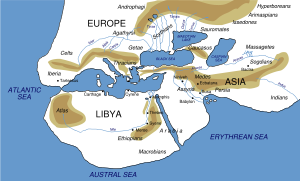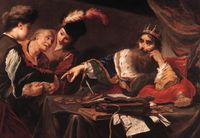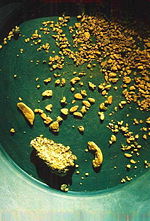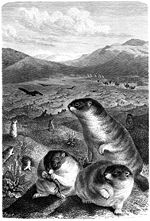Herodotus
2008/9 Schools Wikipedia Selection. Related subjects: Historians, chroniclers and history books
| Herodotus | |
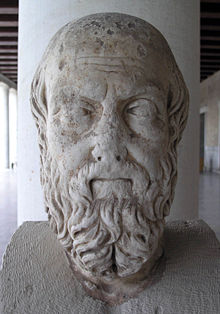 Ostensible bust of Herodotus
|
|
| Born | c. 484 BC Halicarnassus, Ancient Greece |
|---|---|
| Died | c. 425 BC Thurii, Sicily or Pella, Macedon |
| Occupation | Historian |
Herodotus of Halicarnassus (Greek: Ἡρόδοτος Ἁλικαρνᾱσσεύς Hēródotos Halikarnāsseús) was a Greek historian who lived in the 5th century BC ( c. 484 BC– c. 425 BC) and is regarded as the "Father of History" in Western culture. He was the first historian to collect his materials systematically, test their accuracy to a certain extent and arrange them in a well-constructed and vivid narrative. He is almost exclusively known for writing The Histories, a record of his "inquiries" (or ἱστορίαι, a word that passed into Latin and took on its modern connotation of history) into the origins of the Greco-Persian Wars which occurred in 490 and 480- 479 BC—especially since he includes a narrative account of that period, which would otherwise be poorly documented, and many long digressions concerning the various places and peoples he encountered during wide-ranging travels around the lands of the Mediterranean and Black Sea. Although some of his stories are not completely accurate, he states that he is only reporting what has been told him.
Biography
Much of what is known of Herodotus's life is gathered from his own work. Additional details have been garnered from the Suda, an 11th-century encyclopaedia of the Byzantium which likely took its information from traditional accounts. It holds that he was born in Halicarnassus, the son of Lyxes and Dryo, and the brother of Theodorus, and that he was also related to Panyassis, an epic poet of the time. According to this account, after being exiled from Halicarnassus by the tyrant Lygdamis, Herodotus went to live on Samos. Later returning to the land of his birth, Herodotus took part in the ousting of Lygdamis. The traditional biography includes some time spent in Athens, where he is said to have given public readings from his oeuvres and befriended the dramatist Sophocles. It also has Herodotus joining and founding the Hellenic colony Thurii in Southern Italy in 443 BC. His death and burial are placed either at Thurii or at Pella, in Macedon, between 425 and 420 BC.
How much of this is correct we do not know. It was common practice in antiquity for the biographies of poets to be drawn from inferences collated from their works. Something similar may have happened in Herodotus's case. His casting as a tyrannicide may simply reflect the pro-freedom attitude that he expresses in the Histories, while the stays at Samos and Athens may have been invented to explain the pro-Samian and pro-Athenian bias that has often been thought to pervade his work. His exile from Halicarnassus may also be fictional: later historians, such as Thucydides and Xenophon, underwent periods of exile, and their fate may have been later retrospectively imposed on Herodotus by later writers.
Herodotus as historian
| “ | Circumstances rule men; men do not rule circumstances. | ” |
Herodotus provides much information concerning the nature of the world and the status of the sciences during his lifetime. He was arguably the first historian, and certainly the first to travel methodically around the known world in a bid to write more accurately, although this still involved second- and third-hand accounts relating to his primary subject, the Persian wars.
He reports, for example, that the annual flooding of the Nile was said to be the result of melting snows far to the south, and comments that he cannot understand how there can be snow in Africa, the hottest part of the known world, offering an elaborate explanation based on the way desert winds affect the passage of the Sun over this part of the world (2:18ff). He also passes on dismissive reports from Phoenician sailors that, while circumnavigating Africa, they "saw the sun on the right side while sailing westwards". Owing to this brief mention, which is put in almost as an afterthought, it has been argued that Africa was indeed circumnavigated by ancient seafarers, for this is precisely where the sun ought to have been.
Herodotus is one of the sources on Croesus and his fabulous treasures of gold and silver, and many stories about his riches.
Written between 431 and 425 BC, The Histories were divided by later editors into nine books, named after the nine Muses (the "Muse of History", Clio, represented the first book). His accounts of India are among the oldest records of Indian civilzation by an outsider .
Opinions
Herodotus's invention earned him the twin titles " The Father of History", first conferred by Cicero, and "The Father of Lies". As these epithets imply, there has long been a debate—at least from the time of Cicero's On the Laws (Book 1, paragraph 5)—concerning the veracity of his tales and, more importantly, the extent to which he knew himself to be creating fabrications. Every manner of argument has surfaced on this subject, from a devious and consciously-fictionalizing Herodotus to a gullible Herodotus whose sources "saw him coming a long way off".
Criticisms of Herodotus
There are many cases in which Herodotus, not certain of the truth of a certain event or unimpressed by the dull "facts" that he received, reported the several most famous accounts of a given subject or process and then wrote what he believed was the most probable. Although The Histories were often criticized in antiquity for bias, inaccuracy and plagiarism— Claudius Aelianus attacked Herodotus as a liar in Verae Historiae and went as far as to deny him a place among the famous on the Island of the Blessed—this methodology has been seen in a more positive light by many modern historians and philosophers, especially those searching for a paradigm of objective historical writing. Of course, given the sensitivity surrounding the issue, the very foundation of the discipline of history, this has not become a common view; attacks have been made by various scholars in modern times, a few even arguing that Herodotus exaggerated the extent of his travels and invented his sources.
Discoveries made since the end of the 19th century have helped greatly to restore Herodotus's reputation. The archaeological study of the now-submerged ancient Egyptian city of Heracleion and recovery of the so-called "Naucratis stela" give extensive credibility to Herodotus's previously unsupported claim that Heracleion was founded under the Egyptian New Kingdom. Because of this recent increase in respect for his accuracy, as well as the quality and content of his observations, Herodotus is now recognized as a pioneer not only in history but in ethnography and anthropology.
Gold-digging ants
One of the most recent developments in Herodotus scholarship was made by the French ethnologist Michel Peissel. On his journeys to India and Pakistan, Peissel claims to have discovered an animal species that may finally illuminate one of the most "bizarre" passages in Herodotus's Histories. In Book 3, passages 102 to 105, Herodotus reports that a species of fox-sized, furry "ants" lives in one of the far eastern, Indian provinces of the Persian Empire. This region, he reports, is a sandy desert, and the sand there contains a wealth of fine gold dust. These giant ants, according to Herodotus, would often unearth the gold dust when digging their mounds and tunnels, and the people living in this province would then collect the precious dust. Now, Peissel says that in an isolated region of the Deosai Plateau between India and Pakistan there exists a species of marmot (a type of burrowing squirrel) that may solve the mystery of Herodotus' giant "ants". Much like the province that Herodotus describes, the ground of the Deosai Plateau is rich in gold dust. According to Peissel, he interviewed the Minaro tribal people who live in the Deosai Plateau, and they have confirmed that they have, for generations, been collecting the gold dust that the marmots bring to the surface when they are digging their underground burrows.
Even more tantalizing, in his book, "The Ants' Gold: The Discovery of the Greek El Dorado in the Himalayas", Peissel offers the theory that Herodotus may have become confused because the old Persian word for "marmot" was quite similar to that for "mountain ant". Because research suggests that Herodotus probably did not know any Persian (or any other language except his native Greek), he was forced to rely on a multitude of local translators when travelling in the vast polylingual Persian Empire. Therefore, he may have been the unwitting victim of a simple misunderstanding in translation. (It is also important to realize that Herodotus never claims to have himself seen these "ants/marmot" creatures - he may have been dutifully reporting what other travellers were telling him, no matter how bizarre or unlikely he personally may have found it to be. In an age when most of the world was still mysterious and unknown and before the modern science of biology, the existence of a "giant ant" may not have seemed so far-fetched.) The suggestion that he completely made up the tale may continue to be thrown into doubt as more research is conducted.
However, it must be noted that this theory of the marmots fails to take into consideration Herodotus' own follow-up in passage 105 of Book 3, wherein the "ants/marmots" are said to chase and devour full-grown camels; nevertheless, this could also be explained as an example of a tall tale or legend told by the local tribes to frighten foreigners from seeking this relatively easy access to gold dust. On the other hand, all these details of the "ants" are eerily similar to the description of the camel spider ( Solifugae), which strictly speaking is not a spider, and is even sometimes called a "wind scorpion". Camel spiders are said to chase camels (they can run up to 10mph), they have lots of hair bristles, and they could quite easily be mistaken for ants given their rather bizarre appearance. And as has been noted by some, on account of the fear factor of encountering one there have been "many myths and exaggerations about their size" . Images of camel spiders could give the impression that this could be mistaken for a giant ant, but certainly not the size of a fox.
Translations
- Several English translations of The Histories of Herodotus are readily available in multiple editions. The most readily available are those translated by:
- C.E. Godley, 1920; revised 1926. Reprinted 1931, 1946, 1960, 1966, 1975, 1981, 1990, 1996, 1999, 2004. Available in four volumes from Loeb Classical Library, Harvard University Press. ISBN 0-674-99130-3 Printed with Greek on the left and English on the right.
- Aubrey de Sélincourt, originally 1954; revised by John Marincola in 1972. Several editions from Penguin Books available.
- David Grene, Chicago: University of Chicago Press, 1985.
- George Rawlinson, translation 1858–1860. Public domain; many editions available, although Everyman Library and Wordsworth Classics editions are the most common ones still in print.
- Robin Waterfield, with an Introduction and Notes by Carolyn Dewald, Oxford World Classics, 1998.
- Strassler, Robert B., (ed.), and Purvis, Andrea L. (trans.), The Landmark Herodotus, Pantheon, 2007. ISBN 978-0-37542109-9 with adequate ancillary information.
